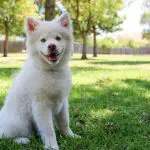Description of the pekingese breed
The proper type of Pekingese has been a subject over which there has been considerable controversy. The most debated point is the size. At one point in the Pekingese history it looked as if there would be two types. Lady Algernon Gordon Lennox suggested one should be called “The Peking Palace dog” and the other should be called “The Peking Spaniel.” It was felt this would cause too much confusion and the suggestion was not implemented. One might guess The Peking Palace Dog was a small version of the Pekingese, and the Peking Spaniel was the larger version.
It is for certain the Pekingese must have a broad head, flat and wide between the ears, not domed or apple-headed. The eyes of Pekingese must be dark, large and lustrous, very prominent and set wide apart.
His muzzle is short, broad, well cushioned up and wrinkled. The Pekingese should have a quaint grotesque expression and not what might be termed a “pretty” face at all. The slightly undershot mouth improves the foreface and finish of the Pekingese as long as the teeth do not show. The nose should be jet black, very broad and flat. The ears in a good specimen of the Pekingese are long and fully feathered. Around the neck there is a bushy mane or frill.
The legs are one of the chief characteristics of the Pekingese, and they should be short and heavy, with as much bone as possible. They are well bowed out at elbows and profusely feathered. The feet are flat and covered with long hair.
The chest of a Pekingese should be broad and deep. The body should be short, heavy in front, and falling away in the loins like that of a Lion. The Pekingese should have a well feathered tail carried high and turned up over the back.
The coat of a Pekingese should be abundant with long thick hair that is soft to the touch, not ever curly. He should have a thick undercoat. The hair on thighs and legs should be particularly long.
Colors are many and include reds, blacks, black and tans, fawn, biscuit, chinchilla, sable and many variously shaded parti-colours. One of the most popular colors of the Pekingese is the rich, golden chestnut, which is found in most of the Goodwood strain. It has been said that in China the most valued color of the Pekingese was a golden fawn. Dogs of that shade are called “Sun Dogs,” because of their glimmering, sunshiny appearance. In the Far East an all white Pekingese would be thought exceedingly rare.
A description found in the “Twentieth Century Dog,” was said to be the words of Her Imperial Majesty Tsze-Hsi, Dowager Empress of China:
“Let the Lion dog be small; let it wear the swelling cape of dignity round its neck; let it display the billowing standard of pomp above its neck.
“Let its face be black; let its forefront be shaggy; let its forehead be straight and low, like unto the brow of an Imperial harmony boxer.
“Let its eyes be large and luminous; let its ears be set like the sail of a war junk; let its nose be like that of the monkey god of the Hindoos.
“Let its body be shaped like that of a hunting Lion spying for its prey.
“Let its forelegs be bent, so that it shall not desire to travel far, or leave the Imperial precincts.
“Let its feet be tufted with plentiful hair, that its footfalls may be soundless; for its standard of pomp let it rival the whisk of the Thibetan yak.
“Let it be lively, that I may afford entertainment by its gambols.
“And for its colour let it be that of a lion, a golden sable, to be carried in the sleeve of a yellow robe, or the colour of a read bear, or a black bear, or a white bear, or striped like a dragon, so that there may be dogs appropriate to every costume in the Imperial wardrobe.

